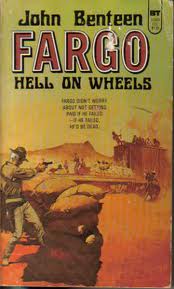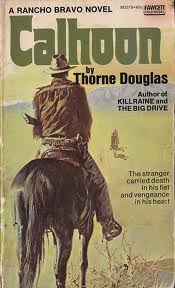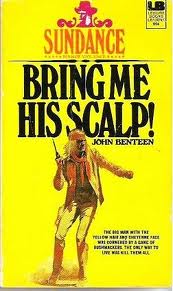Celebrating the Work of Ben Haas
 John C. Hocking introduces me to some of the best fiction I read, although in the case of Ben Haas westerns, it was via sword-and-sorcery scholar Morgan Holmes. I don’t believe anyone is more knowledgeable about sword-and-sorcery than Morgan Holmes. But not just sword-and-sorcery, heroic fiction in general. Hocking’s no slouch himself, though, and some years back when I was hanging out with those two at Pulpcon I had the chance to discover adventure westerns years before I got interested. I remember leaving the convention with Hocking and Holmes and Stephen Haffner (all these h’s in the last name of friends is coincidence, I swear) and dropping by a few great used bookstores. Holmes and Hocking eventually wandered over to the western section. Me, that stuff wasn’t of interest. Westerns?
John C. Hocking introduces me to some of the best fiction I read, although in the case of Ben Haas westerns, it was via sword-and-sorcery scholar Morgan Holmes. I don’t believe anyone is more knowledgeable about sword-and-sorcery than Morgan Holmes. But not just sword-and-sorcery, heroic fiction in general. Hocking’s no slouch himself, though, and some years back when I was hanging out with those two at Pulpcon I had the chance to discover adventure westerns years before I got interested. I remember leaving the convention with Hocking and Holmes and Stephen Haffner (all these h’s in the last name of friends is coincidence, I swear) and dropping by a few great used bookstores. Holmes and Hocking eventually wandered over to the western section. Me, that stuff wasn’t of interest. Westerns?
I suppose I should be generous to myself. With so much sword-and-sorcery fiction still unread by me at that time I know I was trying to stay focused in my interest and research. But I also know that I had some prejudice against reading a western, even though I used to watch and enjoy westerns with my dad. I had about as much interest in reading cowboy stories as I had setting down with a stack of Harlequin romances. Anyway, during that trip I snagged a fine hardback copy of Earth Giant, one of my favorite historical adventure novels, and Hocking pointed me toward some paperbacks by some guy named Richard Meade and another one by Quinn Reade, ’70s sword-and-sorcery novels I’d never heard of. “They’re both by the same guy, Ben Haas,” Hocking informed me. He also explained that many westerns played with the same kind of themes I liked in sword-and-sorcery, although, as with any genre, the good authors are far outnumbered by the mediocre and bad.
It turns out that one of the very best of these western writers was Ben Haas, although good luck finding much written under his real name. The man drafted under a storm of pseudonyms: Ben Elliot, Richard Meade, John Benteen, Thorne Douglas, and maybe a few others. His prose is clean and sharp. He wastes no time on needless exposition, and his pace thunders forward. You never have to wade through the dull stuff, or sigh a little as you skim the sections where the author expounds his pet philosophy. No, Haas got right to the character and the story.
 Ben Haas is best known for three separate series. As Thorne Douglas, he wrote five interconnected books about a Texas cattle outfit named Rancho Bravo that justly have a solid reputation. Randy Johnson has a fine summary of the series without too many spoilers (he doesn’t give away resolutions). He supplies an overview of the series feel at the top of the article, where you can stop if you don’t want to ruin your read with too many particulars.
Ben Haas is best known for three separate series. As Thorne Douglas, he wrote five interconnected books about a Texas cattle outfit named Rancho Bravo that justly have a solid reputation. Randy Johnson has a fine summary of the series without too many spoilers (he doesn’t give away resolutions). He supplies an overview of the series feel at the top of the article, where you can stop if you don’t want to ruin your read with too many particulars.
Writing under the name John Benteen, Haas created three series characters for the old Belmont western paperback line. One of them, Cutler, didn’t seem to take off, although it might be that Haas was simply too busy with the other characters to stick with a third.The other two have an underground reputation for excellence. One was about the soldier of fortune, Fargo, selling his martial services around the turn of the last century. Though packaged as westerns, the Fargos are more like a globe-trotting adventure series, delivering finely-detailed action and excitement.
Haas’ Sundance novels are about a halfbreed Cheyenne in the years after the Civil War. Sundance is another soldier-of-fortune, but he’s also a man of two worlds, trying to find a peaceful way for the Indians and the whites to interact. If you know anything about American history with the Native Americans, you know what a doomed struggle that was. Almost all the money Sundance earns in his exploits is sent to a lawyer/lobbyist in Washington to help fight for Native American rights. Both series are great stuff, but there’s a caveat: formula.
Back when a lot of men read books in their leisure time, there were book lines aimed at men. Belmont specialized in delivering what men wanted to see in a western, so there was plenty of violence and sex with beautiful women, and each came in around 60 thousand words, good for a 2 to 3 hour read on the porch in the evening with your cigarette, or in your hotel room after a long day on the road in your truck. It’s formula work, similar in its ways to a Harlequin. But just because it’s a formula doesn’t mean it can’t be good. Most of the time, in most hands, it won’t be, but… you take a man of real talent and give him a formula, and he creates art.
 If you’re willing to not roll your eyes at the genre conventions, for example the violence and the gorgeous woman who ends up in bed with the protagonist, then you’re in for some fast-paced, sharply described, plot-twisting action. Sure, you know there’s going to be a big gunfight at the end, and you know Sundance will probably end up in a knife or fist fight somewhere near the start, but Haas plays with the rest of the setup every time so you can’t ever be sure how it will all come out. And because he was brilliant, Haas frequently exceeded the genre’s limitations. Mind, this was considered hack work even when Haas was writing it. These were cheap, tawdry paperbacks, and the authors weren’t that well compensated. So there was no real reason for Haas to go above and beyond so often, delivering moving and haunting prose. Some of the Sundance novels are poignant and powerful even as they deliver the requisite action and violence.
If you’re willing to not roll your eyes at the genre conventions, for example the violence and the gorgeous woman who ends up in bed with the protagonist, then you’re in for some fast-paced, sharply described, plot-twisting action. Sure, you know there’s going to be a big gunfight at the end, and you know Sundance will probably end up in a knife or fist fight somewhere near the start, but Haas plays with the rest of the setup every time so you can’t ever be sure how it will all come out. And because he was brilliant, Haas frequently exceeded the genre’s limitations. Mind, this was considered hack work even when Haas was writing it. These were cheap, tawdry paperbacks, and the authors weren’t that well compensated. So there was no real reason for Haas to go above and beyond so often, delivering moving and haunting prose. Some of the Sundance novels are poignant and powerful even as they deliver the requisite action and violence.
The Fargo novels deliver the same kind of goods but somehow have a different feel to them, perhaps because of the far wider variety in setting. So far I find the two series equally enjoyable, although the consensus seems to be that the Fargo novels are stronger. I’ve read all of the Sundance novels but only a few Fargos, so I’m not in a position to weigh in myself. (Addendum — writing now in 2019 I can clearly state that I enjoy the Fargos just as well as the Sundance novels, although I don’t think that they’re necessarily better.) What I do know is that they’re a lot of fun, both from a writer and reader perspective, so long as you don’t read too many of them back to back.
Collecting them to read used to be a little problematic, especially in the case of Sundance. Haas stopped writing both Sundance and Fargo for a few years, and other writers stepped in. None seemed to have been equal to the task, apart from, at least in some instances, Peter McCurtin. As a result, now that both series are available on Kindle, the only other Sundance author the reprints have bothered with besides Haas is McCurtin. If you’re trying to collect in paperback, make yourself a list from those available on Kindle so you don’t accidentally read something pretty wretched… Collecting Fargo, especially the early titles, is pretty simple, as there were multiple reprints. Finding the complete series only becomes complicated because of the scarcity of the later volumes.
For more information on Ben Haas, visit the site of author James Reasoner, who posts about him from time to time. He’s been in correspondence with one of Haas’ sons, sculptor Joel Haas, who provided Reasoner with a fascinating letter from Ben Haas himself all about writing techniques.
17 Comments